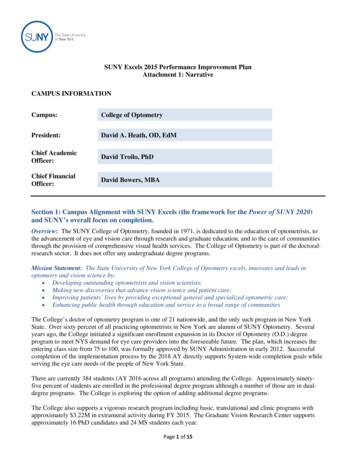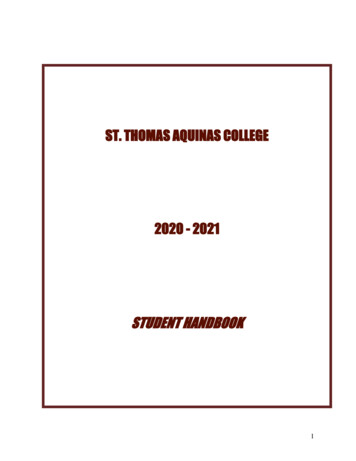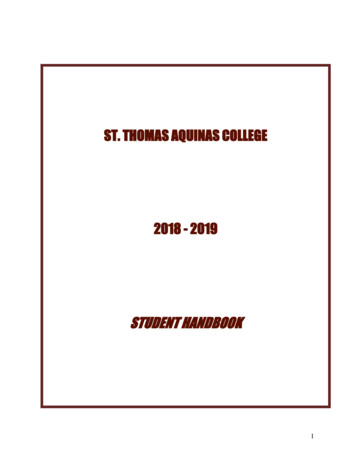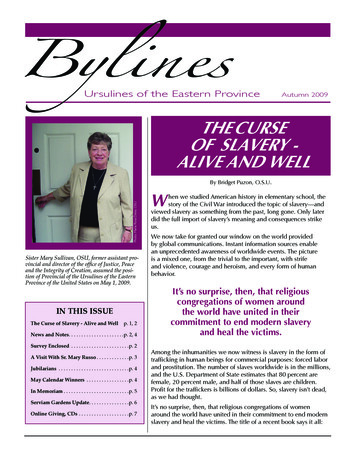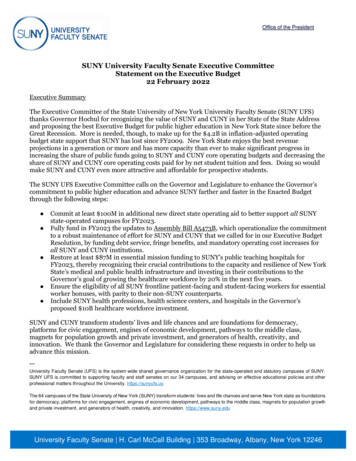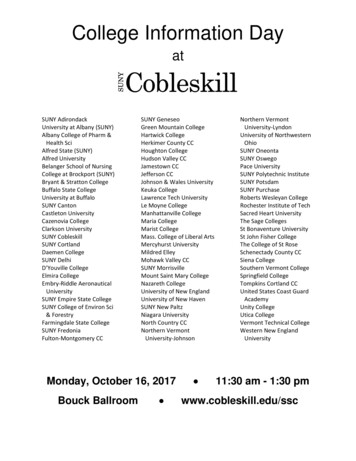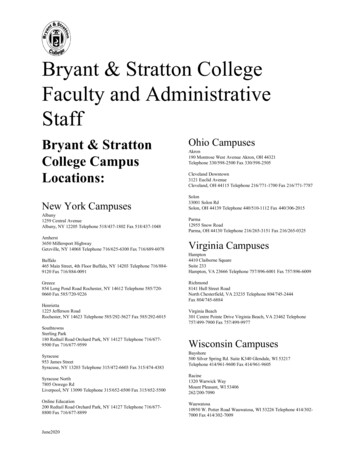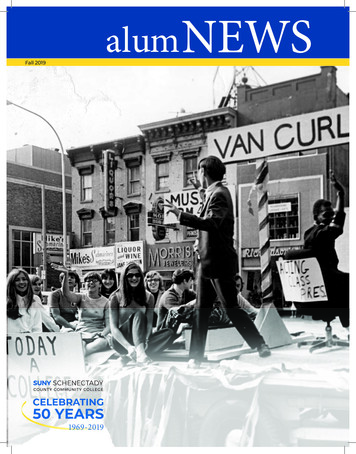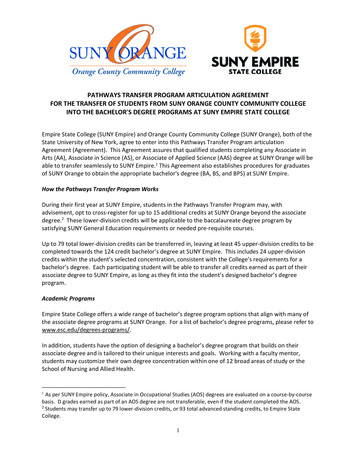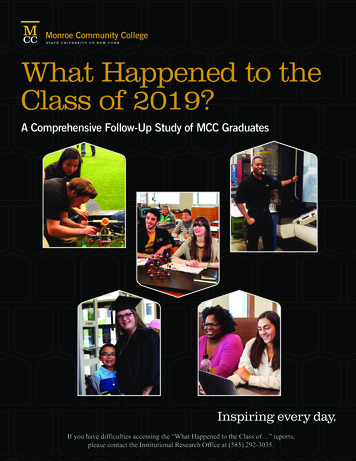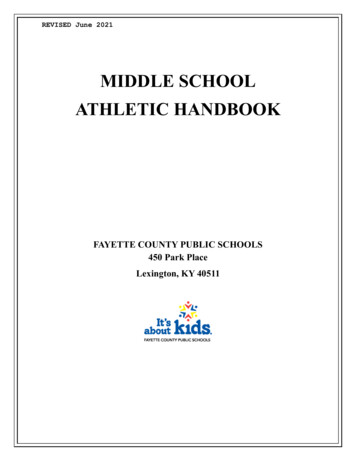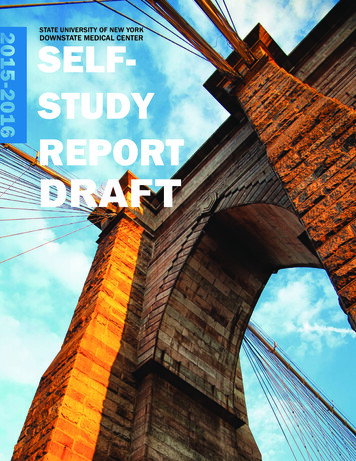
Transcription
STATE UNIVERSITY OF NEW YORKDOWNSTATE MEDICAL CENTERSELFSTUDYREPORTDRAFT
STATE UNIVERSITY OF NEW YORKDOWNSTATE MEDICAL CENTERSELFSTUDYREPORTDRAFTPREPARED FOR THE MIDDLE STATES COMMISSIONON HIGHER EDUCATION
Since the decennial Middle State Commission onHigher Education accreditation site visit in 2006,Downstate has experienced significant growth. Adynamic and effective new president, John F. Williams,MD, EdD, MPH, FCCM, was appointed in 2012 to leadthe institution. The Self-Study Report that followsshares Downstate’s commitment to its mission,reviews how that mission informs strategic planningand resource allocation, and sets the stage for anew round of strategic planning to guide the future.The Report also includes information on the ninespecialty accreditation reviews, covering 93 percentof enrolled students, that Downstate participates inand discusses how this process of continuous reviewcontributes to strong student learning outcomes andimprovement in curricula and campus operations.SUNY Downstate Medical CenterThe campus elected to conduct a ComprehensiveSelf-Study structured on broad-based collaboration. It includes two chairs and a deputy co-chair,as well as an Executive Bridge Committee anda Steering Committee. Six work groups, withmembership reflecting Downstate’s multi-facetedacademic enterprise, examined thirteen of MSCHE’sCharacteristics of Excellence. Standard 12, onGeneral Education, is not applicable to Downstate,and thus was not reviewed. To keep the campusinformed, a Town Hall meeting for the entire campuswas held in March 2014, with a follow-up TownHall scheduled for September 2015. The SteeringCommittee met regularly to review progress on theReport. Downstate’s senior leadership and campusgovernance structures were kept fully briefed as thestudy progressed.EXECUTIVE SUMMARYSUNY Downstate Medical Center is one of fouracademic medical centers in the State University ofNew York 64-campus system. Downstate, which wasfounded in 1860, joined the SUNY system in 1950.Since its founding, Downstate has achieved remarkablesuccess in its mission as a medical university. Fromits start as a single school of medicine, the institutionhas grown to encompass five colleges and schools, ateaching hospital, and a growing research and biotechnology complex with a rich history of commitment toeducational access, community service, and studentand faculty diversity. While Downstate offers bothgraduate and undergraduate degrees, the majorityof students – 82 percent in 2014 – are engaged ingraduate-level study.Downstate’s Self-Study Report begins with an introduction that reviews the components of Downstate’sacademic enterprise and describes the Self-StudyDesign, which comprised six work groups. (SeeAppendix A.)Mission and Goals; Integrity:Standards 1 and 6Work Group 1 documented compliance with Standards 1 and 6. The work group found that Downstate has a specialized and clearly defined mission. It determined that the mission statement isreviewed, is publicized, and guides strategic planning; that institutional goals, as expressed throughSELF-STUDY REPORT 2015ii
EXECUTIVE SUMMARYthe strategic planning process, are congruent with Downstate’s mission; and that Downstate’s role as Brooklyn’sacademic medical center and hub of medical educationis well known to both internal and external stakeholders.The work group further found that Downstate has a strongframework of policies and structures that guides and monitors campus integrity, and maintains an inclusive campusenvironment that embraces diverse perspectives and multicultural populations.Planning, Resource Allocation, Institutional Renewal;Institutional Resources; Institutional Assessment:Standards 2, 3, and 7Work Group 2 documented compliance with Standards 2,3, and 7. The work group found that Downstate’s strategicplanning process is strongly linked to Downstate’s missionand campus goals, and that Downstate’s financial resources clearly support the academic mission. The annual budget process involves the strategic leadership of every college, school, and administrative unit. The mechanisms ofthe budget process include rational and consistent policiesto determine allocation of resources, as well as a continuous feedback loop from plan development to resourceallocation decisions. Institutional controls are in place toprovide strong stewardship of institutional resources andassess effectiveness of programs. Institutional and educational effectiveness are achieved through planning, assessment, and review processes.Leadership and Governance; Administration:Standards 4 and 5Work Group 3 documented compliance with Standards4 and 5. The work group found that, as part of the SUNYsystem, Downstate has a well-defined and effective systemof governance with assigned authority and accountabilityfor policy development, decision making, and advisement.The work group also reviewed the leadership transitionimplemented at Downstate in 2012 with the appointmentof President Williams. Dr. Williams has appointed a coregroup of administrative leaders with appropriate skills, degrees, and training, and who have clearly developed linesof authority and decision making. Since his appointment,Dr. Williams has taken decisive steps to facilitate improvement in operations, structures, services, and productivity.Student Admissions and Retention;Student Support Services: Standards 8 and 9Work Group 4 documented compliance with Standards 8and 9. The work group found that Downstate’s admissionspolicies reflect its standing as a medical university that of-SUNY Downstate Medical Centerfers specialized graduate programs and upper-division undergraduate programs. Student support services are appropriate for student strengths and needs. Financial informationand admissions policies and criteria are clearly delineated,and the information available to prospective applicants iscomprehensive and accurate. Downstate carefully monitorsthe academic progress of students throughout their programs of study and is aggressive in offering academic andother types of counseling to support student success.The majority of Downstate students – 82 percentin 2014 – engage in graduate-level study.Faculty: Standard 10Work Group 5 documented compliance with Standard 10.The work group found that Downstate’s faculty are appropriately qualified for the positions they hold, and there aresufficient faculty to fulfill Downstate’s education missionand the accreditation requirements of specialty accrediting agencies. A new department for Faculty Affairs andProfessional Development was established in 2014 to support faculty success and continued professional growthand to ensure adherence to institutional policies on facultyappointment and promotion. Faculty play a crucial role inmission accomplishment through shared governance andparticipation in curricula review and development.Educational Offerings; Related EducationalActivities; Assessment of Student Learning:Standards 11, 13, and 14Work Group 6 documented compliance with Standards 11,13, and 14. The work group found that Downstate’s educational offerings are congruent with its mission and thatprogram and course content contain rigor and depth appropriate to the degrees offered, with clearly stated learningoutcomes. Support resources, including library services,information technology, and other learning resources, areadequate to support educational offerings. Student learning assessment processes are systematic, sustained, andrelated to Downstate’s educational mission and goals, andinclude direct evidence of student learning.Downstate has been transformed in many ways since 2006and is positioned to meet the complex challenges of thefuture. Downstate’s Self-Study Report documents ourcommitment to educational excellence and student success.SELF-STUDY REPORT 2015iii2
EXECUTIVE SUMMARYSELF-STUDY DESIGN43CHAPTER 7Educational Offerings(Standard 11)CHAPTER 1Mission and Goals(Standard 1)CHAPTER 2Integrity(Standard 6)10CHAPTER 3Leadership and Governance(Standard 4)25CHAPTER 6Student Support Services(Standard 9)INTRODUCTION61837Related Educational Activities(Standard 13)Assessment of Student Learning(Standard 14)59CHAPTER 8Planning, Resource Allocation,Institutional Renewal(Standard 2)Administration(Standard 5)Institutional Resources(Standard 3)CHAPTER 4Faculty(Standard 10)Institutional Assessment(Standard 7)CHAPTER 5Student Admissions and Retention(Standard 8)SUNY Downstate Medical Center71CHAPTER 9Research Questions andRecommendationsSELF-STUDY REPORT 2015TABLE OF CONTENTSiivix1iv
SELF-STUDY DESIGNDEFGORGANIZATIONAL CHARTSDIVERSITY REPORTSUNY POLICIESOF THE BOARD OF TRUSTEESFACULTY DEVELOPMENT PLANLEARNING OBJECTIVESCOLLEGE ENROLLMENTSUNY Downstate Medical CenterHCOLLEGE PROFILES ANDLEARNING OUTCOMESIJCAPITAL IMPROVEMENTFINANCIAL REPORTSTRATEGIC INTENT THE PATH FORWARD(Under Separate Cover)STUDENT HANDBOOK(Under Separate Cover)SELF-STUDY REPORT 2015APPENDICESABCv2
INTRODUCTIONSUNY Downstate Medical CenterSELF-STUDY REPORT 2015vi2
INTRODUCTIONBEFORE THERE WAS A BROOKLYN BRIDGE, BEFORE THE DODGERS CAMEAND WENT, BEFORE THERE WERE ANTIBIOTICS, ANESTHESIA, AND SEPSISCONTROL, THE INSTITUTION THAT WOULD EVENTUALLY BECOME KNOWNAS SUNY DOWNSTATE MEDICAL CENTER TAUGHT ITS FIRST CLASSINTRODUCTIONSTATE UNIVERSITY OF NEW YORKDownstate Medical Center is part of the State Universityof New York (SUNY), the nation’s largest comprehensivesystem of public higher education. SUNY’s dynamiclearning environment encompasses research universities, academic medical centers, liberal arts colleges,community colleges, agricultural and technical institutes,and an online learning network. The University enrollsmore than 460,000 students; offers more than 7,000degree and certificate programs; employs some 88,000faculty and staff; and is represented by 2.4 millionalumni worldwide.DOWNSTATE MEDICAL CENTERSUNY Downstate is one of 64 campuses in theState University system, and comprises a College ofMedicine, School of Graduate Studies, School of PublicHealth, College of Nursing, and College of HealthRelated Professions, as well as extensive research andbiotechnology facilities and its own teaching hospital,the 376-bed University Hospital of Brooklyn. SUNYDownstate also maintains teaching affiliations with abroad network of local hospitals, clinics, and specialtycare facilities, including Kings County Hospital Center,one of the largest public hospitals in New York City. Inthe 2014/15 academic year, Downstate had a totalstudent body of 1,865, a full- and part-time faculty of1,029 (845 full-time, 184 part-time), almost 2,600voluntary faculty, and support staff of approximately3,000. Downstate is the sole academic medical centerserving the three million residents of Brooklyn andStaten Island.Degrees granted include the MD, PhD, DPT, DrPH, MPH,MS, and BS, as well as advanced certificates. In 2014,82 percent of students were enrolled in graduate-levelprograms. Students enrolled in BS programs enter at theupper level; all general education coursework is completedprior to acceptance.SUNY Downstate is located in central Brooklyn, in theheart of the nation’s largest, most ethnically diverse,urban community. If it were a separate city onto itself,Brooklyn, would be the fourth-largest city in the country. Itcontains 66 distinct neighborhoods, many known as hometo specific ethnic or cultural groups, with an estimated90 languages spoken across its borders. The Downstatecampus is physically, and culturally tied to and reflective ofthe community it serves.SUNY Downstate Medical CenterHISTORYDownstate traces its roots back to 1860, when the medicalschool was founded. At that time the science of medicinewas young, and many of the standards of practice taken forgranted today were unknown or in their infancy. When itsdoors opened, the school revolutionized medical educationin the United States. The new school was unique becauseit rejected the idea that physicians should be trainedexclusively in university classrooms and lecture halls, and,for the first time in this country, brought the teaching ofmedicine to the hospital bedside.Downstate is first and foremost an institution of higherlearning for healthcare professionals. It plays an importantrole, nationally and regionally, in the physician and healthcare-professional supply chain. According to the Federationof State Medical Boards, Downstate’s College of Medicineranks fourth out of the nation’s 144 medical schools in thenumber of graduates who hold an active license to practicemedicine. Regionally, this translates into Downstate being thetop producer of physicians in New York State and New York City.Downstate has traditionally served a distinct and diversepopulation of students. The majority of Downstate’s studentsare from Brooklyn itself and the New York City region, manyare from economically and/or educationally disadvantaged backgrounds, and many are immigrants or childrenof immigrants just getting their start in American society.Reflective of our community and mission, all of our collegesGreenpointManhattanNew JerseyWilliamsburgQueensBklyn FortHeights lopeSunsetParkBayRidgeCrownHeights BoroughParkBrownsvilleSUNYDownstateMedical CenterEastFlatbushFlatbushEast New YorkCarnarsieB r o o k l y nBensonhurstFlatlandsSheepshead BayConey IslandManhattanBeachDownstate is located in the center of Brooklyn.SELF-STUDY REPORT 2015vii
INTRODUCTIONand schools have a diverse student population. Downstate’sCollege of Medicine, for example, ranks first among allmedical schools in New York State in the number of minoritystudents enrolled. Nationally, it ranks seventh amongmedical schools in the number of black students graduatedbetween 1980 and 2012 and eighth in the number of Asianstudents. In the 14/15 academic year, the majority of themembers of Downstate’s student body were minorities.Looking at Downstate in 2015, we take pride in our manyachievements. We were the first to offer a direct-entrymidwifery program in the United States, first to establisha gynecologic oncology department, and first to offer abaccalaureate degree in diagnostic ultrasound. Downstatefaculty members were first to produce full-body humanimages using magnetic resonance imaging (MRI) and thefirst to successfully perform open-heart surgery in NewYork State (only the second instance of this procedure tobe performed in the nation). Prototype MRI and heart-lungmachines developed by Downstate faculty are housed inthe Smithsonian Institute. We were the first to establish afederally funded dialysis clinic in the United States, provethat alcoholism has a genetic link, conduct a federal studyof perinatal transmission of HIV disease, and identify theimportant role that nitric oxide plays in cardiovascularhealth. This last discovery led to awarding the 1998 NobelPrize to Downstate faculty member Dr. Robert F. Furchgott.SUNY Downstate has a strong commitment to biomedicalresearch. Its basic scientists, behavioral scientists, clinicians,and public health experts are expanding the scientific body ofknowledge in a broad range of heathcare topics. Downstate’scolleges and schools recognize that faculty membersengaged in research play an important role in providing thelatest biomedical information, creating a vigorous learningenvironment, and instilling the value of scientific explorationamong students. Downstate’s educational divisions offerSUNY Downstate Medical Centerstudents opportunities to pursue clinical, basic, epidemiological or statistical research. Strong research programsthrive in the areas of neuroscience, memory, the geneticsof alcoholism, molecular biology, cardiovascular disease,optical imaging, and the epidemiology of HIV disease.Downstate has launched two biotechnology initiatives tofoster the growth of the biotechnology industry in Brooklynand in New York City: an Advanced Biotechnology Incubatorlocated adjacent to the campus for new start-ups, andBioBAT, a site on the Brooklyn waterfront for more maturecompanies that need larger space. Both sites are part ofStartUp New York, a tax-free initiative launched by NewYork State to promote entrepreneurship and encouragecompanies to work in partnership with New York universities.DOWNSTATE’S COLLEGES AND SCHOOLSAccreditation by Specialty Accrediting BodiesIn 2014, 93 percent of Downstate students were enrolledin programs that had undergone review by specialtyaccrediting bodies in the last five years.In addition to the Middle States Commission on HigherEducation, Downstate’s colleges, schools, and academicprograms are reviewed by nine accrediting bodies: Accreditation Commission for Midwifery Education;Accreditation Council for Occupational Therapy Education;American Physical Therapy Association;Commission on Collegiate Nursing Education;Council on Accreditation of Nurse Anesthesia EducationalPrograms;Council on Education for Public Health;Liaison Committee on Medical Education;Accreditation Review Commission on Education for thePhysician Assistant/Commission on Accreditation ofAllied Health Education Programs;SELF-STUDY REPORT 2015viii
INTRODUCTION Joint Review Committee on Education in DiagnosticMedical Sonography.College of MedicineThe College of Medicine (COM) is one of the oldest medicalschools in the country and, in terms of students enrolled, thelargest allopathic college of medicine in New York State. It iscommitted to remaining at the forefront of medical educationand is notable both for the access to medical education itprovides and for the quality of that education. COM ranks12th out of 144 accredited medical schools in the UnitedStates in the number of graduates who hold faculty positionsat American medical schools and 23rd in the number ofgraduates who are chairs of medical departments.The COM provides a comprehensive medical educationalexperience for all students. Its curriculum recently underwentextensive revision, joining the many schools nationwidethat are adjusting their curricula to take into account thenew skills required of today’s physicians. The new competency-based curriculum integrates the basic sciences withclinical education across all four years of study and providesstudents a thorough grounding in the core competencies.School of Graduate StudiesThe School of Graduate Studies (SGS) is dedicated totraining future scientists and providing students thetools they will need to contribute to the body of scientificknowledge. The SGS grants the PhD degree, and, withthe College of Medicine, sponsors a combined MD/PhDdegree. It offers three career tracks: Cellular and MolecularBiology, Neural and Behavioral Science, and BiomedicalEngineering. In 2011, two new MD/PhD tracks were addedin concert with SUNY Polytechnic Institute’s College ofNanoscale Science and Engineering.A growing percentage of SGS students are pursuing thejoint MD/PhD degree. Graduates of this program areespecially well prepared to bring basic science research tobear on clinical issues. Recent graduates of SGS have beenaccepted to research programs at Mount Sinai MedicalCenter, Duke University, the National Institutes of Health,and New York University.School of Public HealthThe School of Public Health (SPH) is the first new schoolestablished at SUNY Downstate since 1966. It is also thefirst school of public health at a public university in NewYork City, and the first school of public health in Brooklyn.Launched in 2001 as a single-track MPH program in theCollege of Medicine’s Department of Preventive Medicineand Community Health, it formally became an independentschool in 2008, and was fully accredited by the Council onEducation for Public Health (CEPH) in 2010. The schooloffers five master and three doctoral concentrations.The SPH is focused on urban and immigrant health anddedicated to addressing health disparities and healthcareinequities both locally and globally. Recent innovations includeSUNY Downstate Medical Centerthe creation of the Center for Global Health, the Global HealthPractical Field Experience for MPH and DrPH students, theGlobal Health Pathway for medical students, and the PeaceCorps Master’s International Program, launched in 2014. Theschool’s motto is “Public Health for a Global Community.”Students in the School of Public Health represent a broadrange of both healthcare professionals and non-healthcareprofessionals. The majority of students come from minoritygroups, reflecting the rich population diversity of Brooklyn.College of NursingThe College of Nursing (CON), one the largest in New YorkState, offers baccalaureate degree, master’s degree,and postgraduate certificate programs. It is one of onlyfour colleges of nursing in the state to offer degrees in alladvanced nursing specialties (clinical nurse specialist,nurse practitioner, nurse midwifery, and nurse anesthetist).Recently, CON revised its curricula to reflect the AmericanAssociation of Colleges of Nursing’s new core competencies. All of the college’s programs are accredited by theCommission on Collegiate Nursing Education.The CON is noted for its innovative programs, including a15-month accelerated BS program. It recently received agrant from the Robert Wood Johnson Foundation to developinnovative approaches to accelerated nursing educationthat can be taken to scale and replicated in a variety ofeducational settings.The college takes pride in its tradition of educating nursesfrom under-represented backgrounds and in contributing tothe advancement of healthcare and the nursing profession.Many of its students are the first members of their familiesto attend college, and many pursue their academic goalswhile working full-time and caring for their families.College of Health Related ProfessionsThe College of Health Related Professions (CHRP) educatesfuture healthcare professionals in a variety of fields. Sinceits inception in 1966, CHRP has graduated nearly 5,000healthcare professionals. The college offers courses ofstudy leading to bachelor’s, master’s, and doctoral degrees.It provides a challenging and supportive environment thatoffers opportunities for structured experiences as well asindependent inquiry.Six disciplines – physical therapy, occupational therapy,midwifery, physician assistant, diagnostic medical imaging,and medical informatics – provide numerous options forinteresting, sought-after careers. Through CHRP, Downstatedeveloped the nation’s first direct-entry midwifery programand offers the only bachelor’s degree in diagnostic medicalimaging in the metropolitan region.Like the College of Nursing, the College of Health RelatedProfessions attracts a diverse student body, representing awide range of ethnic and minority backgrounds.SELF-STUDY REPORT 2015ix
STATE UNIVERSITY OF NEW YORKDOWNSTATE MEDICAL CENTERSELF-STUDYDESIGN
SELF-STUDY DESIGNSELF STUDY FOSTERS BROAD-BASED CAMPUS DISCUSSION ANDENGAGEMENTSELF-STUDY DESIGNSTEPS TAKEN TO PREPARE FOR THE SELF-STUDYPreparation for the Middle States 2016 site visit beganin 2013 under the leadership of Downstate PresidentJohn F. Williams, who appointed Senior Vice President forPhilanthropy JoAnn Bradley, EdD, to develop the structureand design for the self-study report. Vice President forStudent Affairs and Dean of Students Jeffrey Putman, EdD,was appointed co-chair of the Self-Study. Clinical AssistantProfessor of Emergency Medicine Teresa Smith, MD, wasappointed deputy co-chair.President Williams invited select campus members, representing a broad spectrum of the Downstate community, toserve on the Middle States Steering Committee (MSSC).An Executive Bridge Committee consisting of seniorleadership was also appointed. Several Downstate staffmembers attended the Self-Study Institute in December2013. Downstate’s Council of Deans and Chairs and theCollege Council, a community advisory group that is part ofthe campus governance structure, were briefed and invitedto participate in the Middle States Commission on HigherEducation (MSCHE) campus liaison visit. Based on thesediscussions, the steering committee finalized a timeline,drafted the Self-Study’s basic design framework, andidentified key faculty and administrators to serve on theWork Groups. The MSSC, the Executive Bridge Committee,and the Work Groups participated in a Retreat in March2014 that included an intensive review of the MSCHE’sCharacteristics of Excellence in Higher Education.Downstate chose to pursue a Comprehensive Self-Study,consistent with MSCHE’s Designs for Excellence: Handbookfor Institutional Self-Study.Work Group Structure and ChargesSix Self-Study Work Groups were formed and assignedgroupings of the 13 standards to be addressed in theSelf-Study. (Standard 12, General Education, is notapplicable to Downstate’s educational offerings and istherefore not included in the Self-Study.) A preliminaryinventory of documents to be reviewed was developed foreach Work Group. Members were asked to become familiarwith all MSCHE standards, thoroughly review those withintheir charge, and address research questions. They werebriefed on the timetable, processes to be followed, anddata gathering.It was asked to examine how effectively Downstate hasbeen guided by its Mission, Vision, and Values Statementand how in turn the mission statement reflects Downstate’score values. The Work Group also explored the role ofintegrity in an academic medical center and how ethicalbehavior is intrinsic to the way Downstate defines itself.WORK GROUP 2: STANDARDS 2, 3, AND 7Work Group 2 was asked to consider Downstate’s diverseand evolving institutional needs and priorities relativeto strategic planning, program development, resourceallocation, outcomes assessment, and institutional renewal.The Work Group explored outcomes related to short- andlong-term strategic planning, as well as how resourceallocation supports institutional planning. The Work Groupwas also asked to review how these processes are used toensure institutional sustainability and effectiveness.WORK GROUP 3: STANDARDS 4 AND 5Effective leadership, governance, and administrativestructures are critical to institutional success, goal setting,and accomplishing mission. Work Group 3 was chargedwith exploring how these structures at Downstate supporteffective decision making and how leadership and administration encourage a culture of innovation, teamwork,empowerment, and continuous improvement.WORK GROUP 4: STANDARDS 8 AND 9Work Group 4 was charged with reviewing student supportservices and their relationship to student success. It alsoevaluated how Downstate’s admission policies help ensurea strong, diverse student body and how the Division ofStudent Affairs helps Downstate students achieve theireducational goals.WORK GROUP 5: STANDARD 10Work Group 5 reviewed faculty roles and responsibilitiesand the linkages among scholarship, teaching, studentlearning, research, and service.WORK GROUP 6: STANDARDS 11, 13, AND 14Work Group 6 assessed academic curricula and relatededucational activities.SELF-STUDY PARTICIPANTSWork Group assignments and charges were as follows:MIDDLE STATES STEERING COMMITTEE:CO-CHAIRS: JoAnn Bradley, EdD, Senior Vice President for Philanthropy Jeffrey Putman, EdD, Vice President for Student Affairsand Dean of StudentsWORK GROUP 1: STANDARDS 1 AND 6Work Group 1 was charged with exploring the interdependent relationships between mission, goals, and integrity.DEPUTY CO-CHAIR: Teresa Smith, MD, Clinical Assistant Professor ofEmergency MedicineSUNY Downstate Medical CenterSELF-STUDY REPORT 2015xi
SELF-STUDY DESIGNSTEERING COMMITTEE MEMBERS: Kevin Antoine, JD, Assistant Vice President, Officeof Diversity & Inclusion; Assistant Professor ofHealth Law and Policy, College of Nursing; U.S.Fulbright Scholars Campus Representative Ruth Browne, ScD, Chief Executive Officer, ArthurAshe Institute for Urban Health Joanne Casarella, Student, School of PublicHealth Daisy Cruz-Richman, PhD, RN, Professor andDean, College of Nursing John Dooley, Interim Chief Information Officer Dorothy Fyfe, MPA, Associate Vice President forPolicy and Planning Constance Hill, MD, Clinical Professor ofAnesthesiology, College of Medicine; and Dean,Minority Affairs Johnson Ho, Student, School of Graduate Studies Margaret Kaplan, PhD, OTR, Interim Dean andAssociate Professor, College of Health RelatedProfessions Evan Leung, Student, College of Health RelatedProfessions Emily Levine, Student, College of Medicine Nicholas J. Penington, PhD, Associate Professorof Physiology and Pharmacology Stephan Rinnert, MD, Professor of EmergencyMedicine, College of Medicine; and Vice Chairmanfor Faculty Development and Education Joyce Sabari, PhD, OTR, FAOTA, AssociateProfessor and Chair of Occupational Therapy,College of Health Related Professions Moro Salifu, MD, MPH, Professor and Chair ofMedicine, College of Medicine Laila Sedhom, PhD, RN, Professor and AssociateDean for Graduate Programs, College of Nursing Mark Stewart, MD, PhD, Dean, School of GraduateStudies Stephen Wadowski, MD, Clinical AssociateProfessor of Pediatrics, College of Medicine; andAssociate Dean for Graduate Medical Educationand Designated Institutional Officer Richard Winant, PhD, Dean of Academic InformationAccess and Director of Libraries EXECUTIVE BRIDGE COMMITTEE MEMBERS: Astra Bain-Dowell, MPA, Executive Vice President andChief Executive Officer JoAnn Bradley, EdD, Senior Vice President for Philanthropy Melanie F. Gehen, MHSA, Vice President for FinancialAffairs Jeffrey S. Putman, EdD, Vice President for StudentAffairs, and Dean of Students Pamela D. Sass, MD, Senior Associate Dean forAcademic Affairs and Acting Dean, College of Medicine COUNCIL OF DEANS AND CHAIRS Ovadia Abulafia, MD, Professor and Chair of Obstetricsand Gynecology SUNY Downstate Medical Center Antonio Alfonso, MD, Distinguished TeachingProfessor and Chair of SurgeryAstra Bain-Dowell, MPA, Executive Vice President andChief
appendices suny downstate medical center self-study report 2015 2 a self-study design b diversity report c suny policies of the board of trustees d organizational charts e faculty development plan f learning objectives g college enrollment h college profiles and learning outcomes i capital improvement j financial report strategic intent - the path forward
